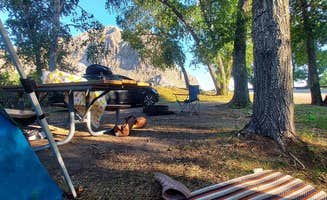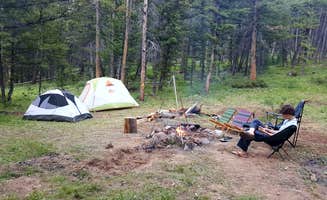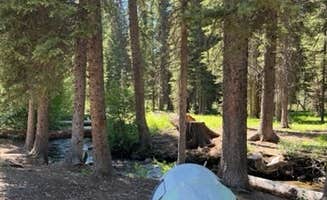Tent camping near Lima, Montana offers primitive to semi-developed options across varied terrain at elevations ranging from 5,600 to 7,000 feet. The camping season typically runs from late spring through early fall when mountain roads become accessible. Nighttime temperatures drop significantly even in summer months, requiring proper cold-weather gear for comfortable overnight stays.
What to do
Fishing access points: Multiple camping areas near Lima provide direct access to streams and reservoirs. At Timber Creek Reservoir, campers can enjoy fishing directly from their sites. As one visitor noted, "If you have means to filter water, no problem. Trails are well maintained, beautiful hikes!"
Mountain hiking: The surrounding mountains offer trails for day hiking without requiring extensive backcountry preparation. Near Big Eightmile Campground, a camper reported, "Dairy creek trail was a short and fun trail. Able to complete it and the water was super clear and pretty." Some trails become inaccessible due to snow or fallen trees, requiring flexibility in plans.
Wildlife viewing: The region supports diverse wildlife populations including waterfowl, deer, and smaller mammals. The undeveloped areas around Lima create natural habitats where animals frequent camping areas, especially at dawn and dusk. Canadian geese are common near water sources, with one camper at Barretts Station mentioning being "serenaded by Canadian Geese nesting on the nearby cliff."
What campers like
Water proximity: Sites near rivers and reservoirs are particularly valued. At Timber Creek Campground, campers appreciate the dual water access as noted in this review: "This campground has 2 streams running on both sides of it so most camp spots have access right into the water. There are 12 or so camp spots."
Low occupancy rates: Even during peak season, many campgrounds maintain relatively low visitor numbers. The same reviewer at Timber Creek Campground observed, "I was worried I wouldn't get a spot so I got there early. Only 1 other family was camping there." This allows for greater site selection and more privacy than typically found in more developed camping regions.
Minimal light pollution: The remote location provides exceptional night sky viewing conditions. From the West Dubois area, one camper mentioned, "See the Tetons to the east at sunrise, it's beautiful." The minimal development throughout the region preserves natural darkness for astronomy enthusiasts.
What you should know
Insect preparation: Mosquitoes can be extremely problematic at certain times, particularly near water sources. As one camper at Barretts Station Park Campground warned, "Bugs are INTENSE though!" Another noted, "prepare for the skeeters our thermacell was no match for these guys." Standard repellents may be insufficient during peak mosquito season.
Water availability: Many campsites lack reliable water sources. When available, hand pumps may be unreliable or non-functional. At Barretts Station, a visitor mentioned, "There is also a day use area across the bridge with another restroom and a hand pump well (also a hand pump well in the camping area but was not working when we visited)."
Road noise considerations: Campgrounds near Interstate 15 experience significant traffic noise. One Barretts Station camper reported, "It was close to the freeway, so there was lots of road noise all night." Sites further from major roadways provide quieter alternatives for noise-sensitive campers.
Tips for camping with families
Shade structures: Many sites lack natural tree cover. At Lone Tree Campground, a camper appreciated that "There is no shade but each camp site has a shade structure, picnic table, and fire pit." These amenities prove essential during hot summer days, particularly for families with children.
Water recreation access: Reservoir access points provide family-friendly swimming and water play areas during hot weather. The same Lone Tree visitor reported, "We had fun walking along the lake and splashing around." These shoreline activities require minimal equipment and provide entertainment for younger campers.
Emergency services distance: Most camping areas sit 20-30 minutes from the nearest medical facilities. When camping with children, knowing the location of the closest services becomes crucial. The small towns surrounding Lima have limited healthcare options, with the nearest full-service hospital located in Dillon, approximately 30 miles north.
Tips from RVers
Limited designated spaces: Most areas near Lima feature informal parking rather than developed RV sites. At West Dubois Pulloff, a camper advised, "The turn off to the south is difficult to see at night, it's just two wheel tracks... the road was a little rutted but the camp area was flat." RVs should scout potential sites before attempting to navigate unmarked access roads.
Convenience store proximity: Some camping areas benefit from nearby services despite their remote feel. A camper at Barretts Station noted, "also less than a mile away there was a gas station so if you need flush toilets or a beer run it's super close." This accessibility provides peace of mind for RV campers needing supplies or dump station access.
Limited level parking: Finding sufficiently level areas for larger rigs presents challenges in the undeveloped sites. Even in more established areas like Barretts Station, one visitor found "It's basically a park with 2 RV spots tucked in at the end that were taken. The rest of 'camping' is free in the gravel lot." Arriving early improves chances of securing suitable parking.




